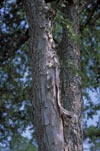Home >
Ulmus crassifolia, Cedar Elm
Cedar Elm is commonly planted in Texas as a street tree and could make a good tree in Florida. It tolerates the rigors of urban life quite well. With some pruning when the tree is young to space major branches along a central trunk, trees are relatively low maintenance. Regular pruning may be needed for street trees in order to remove drooping branches. One of the best attributes of this tree is its tolerance to alkaline and wet soils. This makes it a good choice for planting in parking lot islands and along streets and other tough sites with compacted soil. Except for its susceptibility to Dutch Elm Disease, this would make it a good candidate for planting in urban areas. Pollen from flowers in the fall contribute to allergies. Wings on twigs are less prominent than on winged elm.
Cedar Elm should be grown in full sun on well-drained soil, acid or alkaline. It is very drought-tolerant once established and tolerates wet soil well. It would be a low maintenance shade and street tree except for its thick, stiff, somewhat drooping branches. Maintain a regular pruning and training program in the early years after transplanting. Strive to keep branches no larger than about half the diameter of the trunk.
Existing trees are occasionally left near new homes and other buildings in new developments. Roots damaged by construction equipment can decay quickly. This can leave the plant with few supporting roots in the years following construction despite a green canopy. This and many other trees treated like this could fall over as a result. In addition, branches that are suddenly exposed to unlimited light when nearby trees are removed begin to grow rapidly. As a result, they could become too long and break. Keep them shortened with reduction cuts to help prevent breakage.
Elms are among those susceptible to summer branch drop according to surveys in California. Summer branch drop is a phenomena resulting in failure and breakage of large diameter, live branches typically on calm summer days.
The
wood is considered ring porous which means that there is a large difference
in size between the spring wood pores and the summer wood pores. All elms
reportedly produce allergenic pollen.






